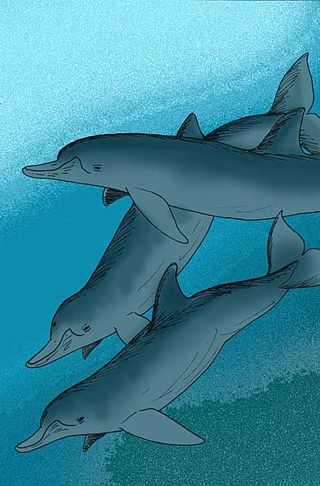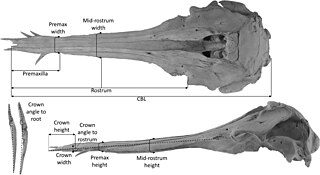Mammalodon is an extinct genus of archaic baleen whale belonging to the family Mammalodontidae.

Australodelphis mirus is an extinct Pliocene dolphin. A. mirus is known from fossils found in the Sørsdal Formation, Mule Peninsula, Vestfold Hills, East Antarctica. The genus has been described as an example of convergent evolution with beaked whales.

Waipatiidae is an extinct family of odontocetes currently known from the Oligocene of the Pacific Ocean and possibly Europe and the Caucasus.

Cetotheriidae is a family of baleen whales. The family is known to have existed from the Late Oligocene to the Early Pleistocene before going extinct. Although some phylogenetic studies conducted by Fordyce & Marx 2013 recovered the living pygmy right whale as a member of Cetotheriidae, making the pygmy right whale the only living cetotheriid, other authors either dispute this placement or recover Neobalaenidae as a sister group to Cetotheriidae.

Kairuku is an extinct genus of penguin. It contains three species, K. grebneffi, K. waitaki and K. waewaeroa. This taxon is known from bones from 27 MYA, from the Kokoamu Greensand Formation of New Zealand. It was historically referred to as Palaeeudyptes.
The Kokoamu Greensand is a geological formation found in New Zealand. It is a fossil-bearing, late Oligocene, greensand rock unit of the eastern South Island, especially the Waitaki District of North Otago and the southern Canterbury region. The formation was named by geologist Maxwell Gage in the 1950s. In North Otago it underlies the thicker and harder Otekaike Limestone. The formation gets its green colour from the mineral glauconite which forms slowly on the ocean floor.
Eomysticetus is an extinct genus of baleen whale from the late Oligocene (Chattian) Chandler Bridge Formation of South Carolina.
This paleomammalogy list records new fossil mammal taxa that were described during the year 2014, as well as notes other significant paleomammalogy discoveries and events which occurred during that year.
Mauicetus is a genus of extinct baleen whale from the Late Oligocene of New Zealand.
Tohoraata is a genus of eomysticetid baleen whale from the Late Oligocene (Chattian) of New Zealand. There are two recognized species, T. raekohao and T. waitakiensis.
Eomysticetidae is a family of extinct mysticetes belonging to Chaeomysticeti. It is one of two families in the basal chaeomysticete clade Eomysticetoidea.
Tokarahia is a genus of eomysticetid baleen whale from the Late Oligocene (Chattian) of New Zealand. There are two recognized species, T. kauaeroa and T. lophocephalus.

Waharoa is a genus of eomysticetid baleen whale from the Late Oligocene (Chattian) of New Zealand. It was identified with the discovery of Waharoa ruwhenua by Boessenecker and Fordyce (2015), which added a new genus and species to a monophyletic family Eomysticetidae.

Horopeta is a genus of baleen whale from the Late Oligocene (Chattian) Kokoamu Greensand of New Zealand.
This paleomammalogy list records new fossil mammal taxa that were described during the year 2016, as well as notes other significant paleomammalogy discoveries and events which occurred during that year.
Whakakai is a genus of baleen whale from the Late Oligocene (Chattian) Kokoamu Greensand of New Zealand.
Xenorophus is a genus of primitive odontocete from late Oligocene (Chattian) marine deposits in South Carolina. It belongs to the Xenorophidae.
Toipahautea is a genus of baleen whale from the Late Oligocene (Chattian) Kokoamu Greensand of New Zealand.

Nihoroa is an extinct genus of waipatiid odontocete cetacean from the glauconitic Otekaike Limestone in North Otago; New Zealand. The type species is N. reimaea, known from only the holotype which comprises various skull elements.






